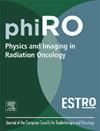带静态端口和动态准直的旋转电弧治疗降低了食管癌患者的心肺剂量,并降低了基于模型的质子治疗的预测获益
IF 3.3
Q2 ONCOLOGY
引用次数: 0
摘要
背景和目的减少对肺和心脏的剂量对于减少食管癌患者接受三位一体治疗的毒性至关重要。本研究比较了一种结合旋转弧线、静态光束角度和动态准直(RAD)的新技术与标准调强放疗(IMRT)和质子治疗(PT)的效果。材料和方法为来自PROTECT试验的10例患者创建了rad计划,这些患者在临床imrt计划中具有较高的平均肺剂量。对于所有技术,优化优先考虑肺保留。使用经过验证的ntcp模型估计预测的肺并发症风险。对IMRT、RAD和PT进行比较,并评估对基于模型的PT转诊的影响(ΔNTCP > 10%)。结果与IMRT相比,rad降低了平均肺剂量(中位数10.2 Gy [8.3-12.5 Gy]比12.0 Gy [10.2 - 16.3 Gy], p < 0.01),同时也降低了平均心脏剂量(中位数24.1 Gy [20.9-25.0 Gy]比25.7 Gy [21.9-26.1 Gy], p < 0.01)。PT达到了最大的节约,平均肺剂量降至5.1 Gy [2.8-7.1 Gy],平均心脏剂量降至9.8 Gy [6.4-13.6 Gy](与RAD相比p <; 0.01)。与IMRT相比,RAD预测肺部并发症的风险平均降低7% (p < 0.01),个别患者ΔNTCPs的范围从2%到19%不等。PT提供了进一步的好处,与RAD相比,平均ΔNTCP减少11% (p < 0.01)。9个imrt计划有基于模型的pt转诊,而rad计划只有5个。结论与IMRT相比,rad降低了食管癌三段式治疗患者的肺和心脏剂量,降低了肺部并发症的预测风险,影响了pt转诊的决定。本文章由计算机程序翻译,如有差异,请以英文原文为准。

Rotational arc treatments with static ports and dynamic collimation reduces cardiopulmonary dose for esophageal cancer patients and diminishes model-based predicted benefit of proton therapy
Background and purpose
Reducing dose to the lungs and heart is essential to minimize toxicity in esophageal cancer patients undergoing trimodality therapy. This study compared a new technique combining rotational arcs, static beam angles and dynamic collimation (RAD) against standard intensity-modulated radiotherapy (IMRT) and proton therapy (PT).
Materials and methods
RAD-plans were created for ten patients from the PROTECT trial who had high mean lung doses in their clinical IMRT-plan. For all techniques, optimization prioritized lung sparing. Predicted pulmonary complication risks were estimated using a validated NTCP-model. Comparisons were made between IMRT, RAD, and PT, and the impact on model-based PT-referral (ΔNTCP > 10 %) was assessed.
Results
RAD lowered mean lung dose compared with IMRT (median 10.2 Gy [range 8.3–12.5 Gy] versus 12.0 Gy [10.2–16.3 Gy], p < 0.01) and also incidentally reduced mean heart dose (median 24.1 Gy [20.9–25.0 Gy] versus 25.7 Gy [21.9–26.1 Gy], p < 0.01). PT achieved the greatest sparing, with mean lung dose reduced to 5.1 Gy [2.8–7.1 Gy] and mean heart dose to 9.8 Gy [6.4–13.6 Gy] (both p < 0.01 compared to RAD). RAD reduced the predicted pulmonary complication risk versus IMRT on average 7 % (p < 0.01), with individual patient ΔNTCPs ranging from 2 % to 19 %. PT offered further benefit, with an additional average ΔNTCP reduction of 11 % compared to RAD (p < 0.01). Model-based PT-referral was indicated for nine IMRT-plans versus only five RAD-plans.
Conclusion
RAD reduced lung and heart dose compared to IMRT in esophageal cancer patients undergoing trimodality treatment, lowering predicted risk for pulmonary complications, which influenced PT-referral decisions.
求助全文
通过发布文献求助,成功后即可免费获取论文全文。
去求助
来源期刊

Physics and Imaging in Radiation Oncology
Physics and Astronomy-Radiation
CiteScore
5.30
自引率
18.90%
发文量
93
审稿时长
6 weeks
 求助内容:
求助内容: 应助结果提醒方式:
应助结果提醒方式:


